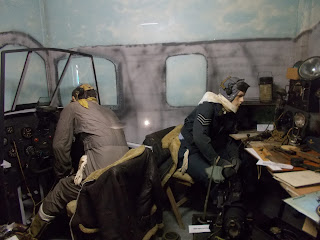HEAVY BOMBER COCKPIT MOCK UP
We have a mock up of a heavy bomber's cockpit in building 2.
One of the things that the school children find unbelievable is all the equipment that a navigator would have to use to work out the plane's position. No Sat Navs,no GPS, no computer, just the ability to work out the position by using a map, a compass and at times intuition.
To qualify as a navigator in WWII there were 500 hours ground instruction and 100 hours air training.
The final qualification test was to plot a route with no more than 11 degrees of error and less than 1 minute off per hour of flight time. At night they had to reach within 15 miles of a target.
There were radio beacons to assist the navigator on the homeward flight.
GEE was a radio navigation system that came into service with Bomber Command in 1942. It measured the time delay between 2 radio signals to produce a fix with an accuracy of around a few hundred metres.
Our mock up shows a Flt Sgt working as the wireless operator. Again this would be so different today with all the technology now available.
According to my father's log book, the course for a wireless operator was just 6 weeks. A total of 34 hours was spent training on the ground and then 11 hours 50 minutes transmitting in the air. My father got straight A's in all the technical and actual training and had 18 words per minute in Morse Code.
The pilots of WWII wouldn't recognise the cockpits in today's planes, civil or military. The ability to land a civil air liner automatically would be unbelievable to them. They relied on the rest of the crew for accurate information, all the time keeping the plane on course. The training was the most intense of all the crew (too much to go into here) and pilots were always Commissioned Officers.
The one outstanding detail of all the WWII crews was the young ages. Squadron Leaders at 26 years old wasn't unusual. All these men who were prepared to pay the ultimate price, and so many did.
One of the things that the school children find unbelievable is all the equipment that a navigator would have to use to work out the plane's position. No Sat Navs,no GPS, no computer, just the ability to work out the position by using a map, a compass and at times intuition.
To qualify as a navigator in WWII there were 500 hours ground instruction and 100 hours air training.
The final qualification test was to plot a route with no more than 11 degrees of error and less than 1 minute off per hour of flight time. At night they had to reach within 15 miles of a target.
There were radio beacons to assist the navigator on the homeward flight.
GEE was a radio navigation system that came into service with Bomber Command in 1942. It measured the time delay between 2 radio signals to produce a fix with an accuracy of around a few hundred metres.
Our mock up shows a Flt Sgt working as the wireless operator. Again this would be so different today with all the technology now available.
According to my father's log book, the course for a wireless operator was just 6 weeks. A total of 34 hours was spent training on the ground and then 11 hours 50 minutes transmitting in the air. My father got straight A's in all the technical and actual training and had 18 words per minute in Morse Code.
The pilots of WWII wouldn't recognise the cockpits in today's planes, civil or military. The ability to land a civil air liner automatically would be unbelievable to them. They relied on the rest of the crew for accurate information, all the time keeping the plane on course. The training was the most intense of all the crew (too much to go into here) and pilots were always Commissioned Officers.
The one outstanding detail of all the WWII crews was the young ages. Squadron Leaders at 26 years old wasn't unusual. All these men who were prepared to pay the ultimate price, and so many did.




Comments
Post a Comment